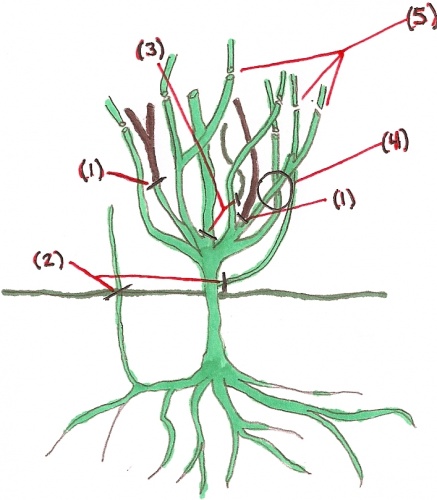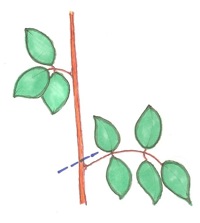There are no products in your shopping cart.
Guide to Pruning Roses
June 14th, 2011
Guide to Pruning Roses
We receive a lot of questions on the topic of pruning roses so here is a quick guide to keep roses healthy and producing flowers.
The how and why: (See diagram on the right)
(1) The first pruning cuts should be to remove all the deador damaged canes, dead and damaged canes will attract insects and disease.
(2) Your next cuts should be to remove any suckers growing below or away from the main stem.*
(3) The next pruning cuts should be to remove any large old canes and very thin elongated canes about the size of a pencil, both are less vigorous and will produce fewer flowers.
(4) Next its time to remove any canes that are rubbing onanother adjacent cane. When two living canes rub together they can create open wounds, which opens the plant disease and insects.
(5) The final cuts should be made to control size and shape, the overall height will depend on the type of rose you are growing.
The when: In cold climates roses should be pruned in early spring when the buds just begin to turn pink and plump up. In frost free climate zones its best to prune roses in the fall. Remember roses bloom on new wood so pruning too late in the spring may reduce the number of blooms. During the growing season roses can be "Deadheaded" which is the removal of faded flowers before they can develop rose hips. Common deadheading practice on roses is to find the point on a rose stem where the first leaf has 5 leaflets is located and make your cut just above that point. (See diagram below) When pruning roses with flower clusters remove the spent flowers as they occur or the entire flower set all at once.

* Suckers are shoots that grow from the rootstock rather than from the named variety of rose.
- Login to post comments
Recommeded Products
Corona Pruner Sheath
$11.95Ecoforms Saucer 14
$1.00Ginseng Ficus Bonsai Tree
$169.95
On Sale
Okatsune Pruners 8"
$39.95Mini Herb Pail
$12.99EcoForms Herb Garden Kit
$14.95





